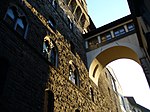Torre dei Mannelli
Commons link is defined as the pagenameTowers in Florence

The Torre dei Mannelli is a small tower on the southeast corner of the Ponte Vecchio bridge in Florence, Italy. It is the only survivor of the four towers that once defended each corner of the bridge. In 1565, the Mannelli family refused to have it altered or demolished so that the Vasari Corridor (a corridor commissioned by duke Cosimo I de' Medici to join the Uffizi with Palazzo Pitti on the other side of the river) could be built in a straight line. Instead the corridor swerved round it on brackets. The tower was damaged during World War II and was restored by architect Nello Baroni in 1944-1946. The ground floor now houses a gelateria.
Excerpt from the Wikipedia article Torre dei Mannelli (License: CC BY-SA 3.0, Authors, Images).Torre dei Mannelli
Ponte Vecchio, Florence Quartiere 1
Geographical coordinates (GPS) Address External links Nearby Places Show on map
Geographical coordinates (GPS)
| Latitude | Longitude |
|---|---|
| N 43.767536111111 ° | E 11.252958333333 ° |
Address
Torre dei Mannelli
Ponte Vecchio
50125 Florence, Quartiere 1
Tuscany, Italy
Open on Google Maps











